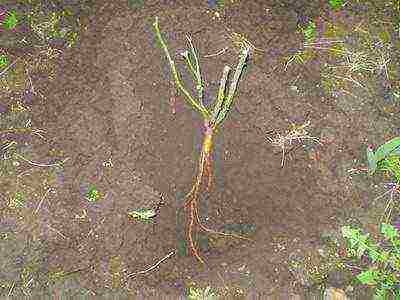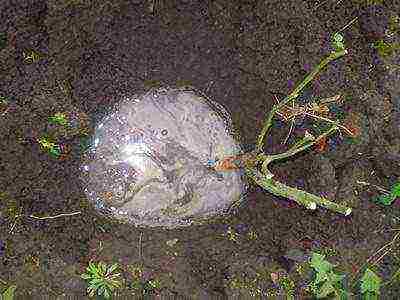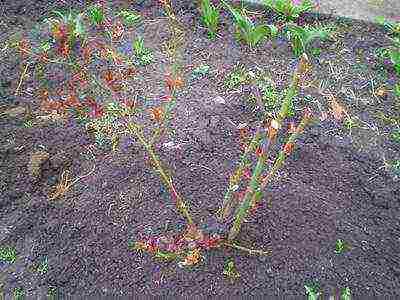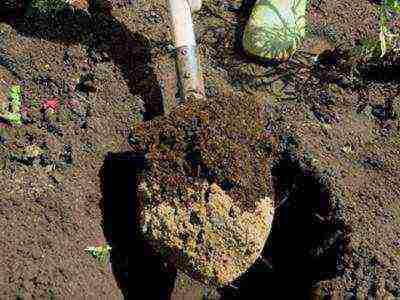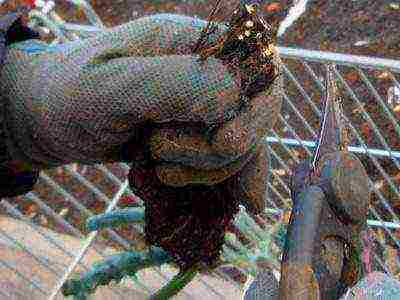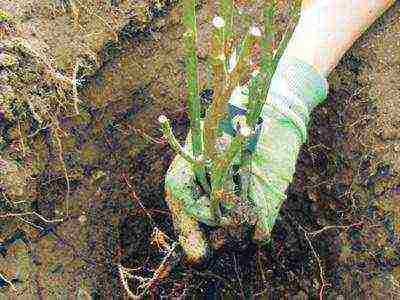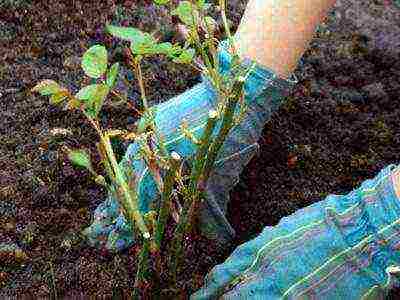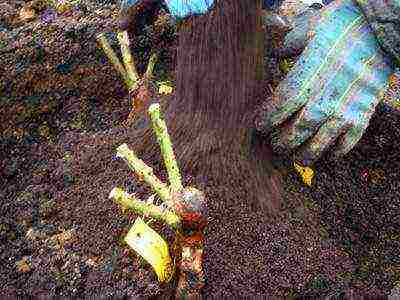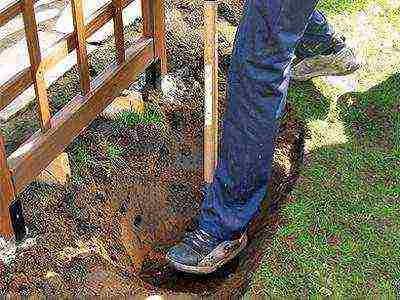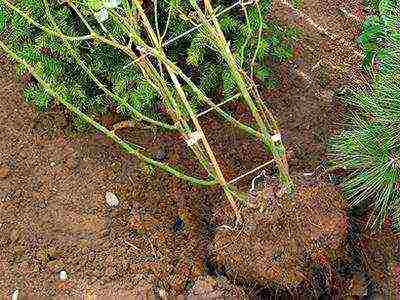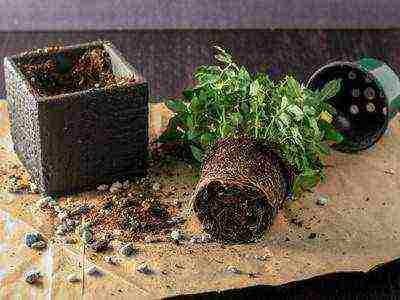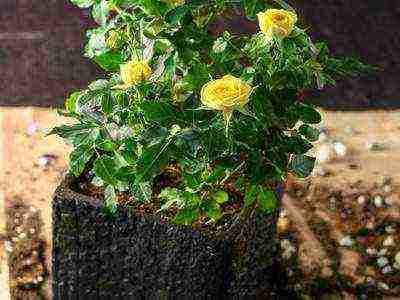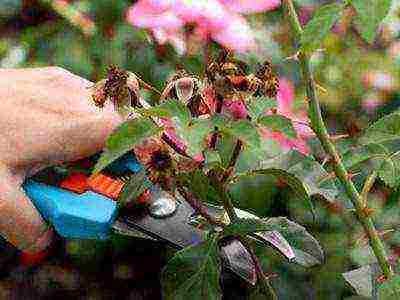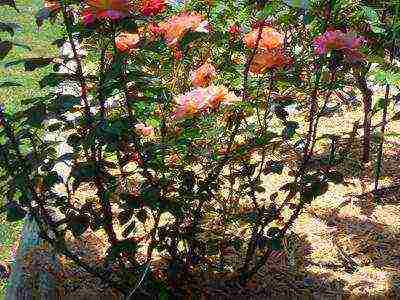Content
- 1 Choosing the best place to plant roses
- 2 How to properly plant a rose in the ground (with video)
- 3 How to plant roses correctly: the distance between the bushes when planting
- 4 How to properly care for roses (with photo and video)
- 5 Choosing a landing site
- 6 Preparing the soil for roses
- 7 Preparing seedlings
- 8 Planting roses in autumn in 6 steps
- 9 What to do if you are late with planting roses?
- 10 How to choose a place for planting spray roses
- 11 Planting and caring for rose bushes (with photo)
- 12 How to transplant roses to another place
- 13 How to prepare the soil for planting roses
- 14 Distance between roses when planting in the ground
- 15 When to transplant roses: transplant to another location in the summer
- 16 How to properly prune climbing roses
- 17 Watering and mulch: how to water and mulch roses
Choosing the best place to plant roses
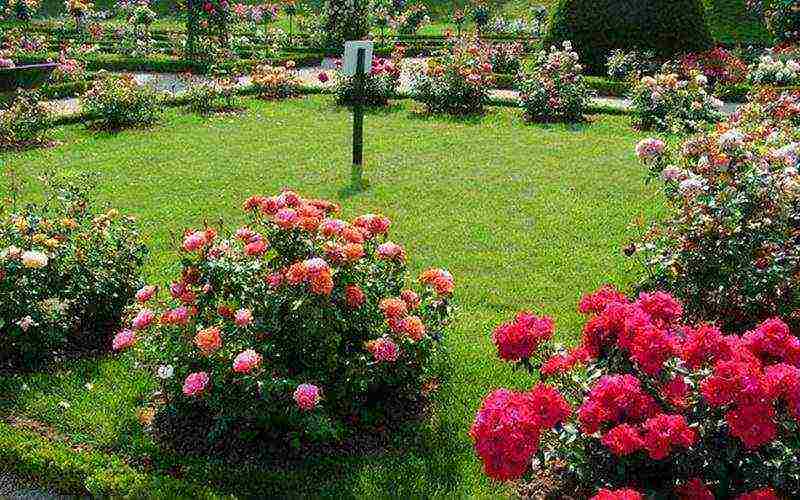
Roses at their summer cottage (photo)
When choosing a place to plant roses, do not forget that these plants love fertile, humus-rich, light garden soil. They grow well on chernozems, light loams and sandy loams with a good structure and a high content of organic matter. The soil is desirable slightly acidic (pH 5.5-6.5).
Roses need a minimum of 5-6 hours of sun per day and an open location where the breeze blows from all directions. In the bright sun near the southern wall, the roses will feel bad, here leaf burns are possible, and the color of the flower quickly fades.
Some varieties put up with partial shade. In thickened and poorly ventilated places, roses are more likely to get sick.
Do not plant roses close to buildings, they cannot stand it. It is better to plant climbing roses not near the wall of the house, but at least 20-25 cm away from it. The soil near the wall is usually dry and there is a lot of lime in it.
Not the best place to plant roses - next to the cobbled paths, there is too much warmth here too. If the roses in the container are on the balcony, loggia or paved area in the country, often (morning and evening) spray them with water.
Do not plant roses under pitched roofs or under frequently dripping trees; they cannot stand the dripping water from above.
For the correct planting of roses, organic fertilizers must be applied to the selected area before winter, dug up and left so that the clods of earth are frozen and scattered in the spring. On steep slopes, roses can be grown on terraces. In the shade, they are drawn to the light and bloom poorly.
Most roses are grafted on rose hips, the roots of which go relatively deep into the ground. This circumstance must be taken into account when choosing a place for planting bushes. The high level of underground water causes yellowing of leaves and contributes to the development of fungal diseases. Roses love to be flooded with water from time to time, especially during dry periods, but they cannot stand a high level of groundwater. The permissible depth of such waters for them is 100 cm.
Before planting roses correctly, you should consider which plants grew before them. A number of horticultural crops are not suitable as predecessors of the rose. First of all, this applies to representatives of the entire family of Rosaceae and to almost all fruit trees, which take the same nutrients from the soil as roses. Therefore, before planting roses, the soil must be thoroughly fertilized.
Roses should not be planted too close to trees, especially those whose roots take a lot of nutrients and moisture from the soil. This applies to birches, maples, elms, ash. The place under the crowns of trees is completely unsuitable for roses. In the garden, it is not recommended to plant roses in the immediate vicinity of berry fields, beds with vegetables and green crops, as well as fruit bushes. It's not just aesthetics. With such a neighborhood, it is impossible to carry out protective spraying of roses against powdery mildew, aphids, thrips and a host of other pests and diseases - the harvest of neighboring crops will become inedible.
To the detriment of roses and a constant drying draft, which usually occurs near the corners of buildings, in the aisles between them. They also do not like closed places in yards or gardens built on all sides, surrounded by high blank fences. Air movement is essential for the healthy growth of roses.It should not be limited by framing roses with dense plantings of other shrubs.
When properly planted and cared for outdoors, roses will delight you for many years.
How to properly plant a rose in the ground (with video)
Before planting roses correctly, you need to dig holes of about 40x40x30 cm so that the roots can freely fit in them. For large bush and climbing roses, larger pits are prepared. If the roots bend in a small hole during planting, the plants will develop poorly, bloom poorly and are more likely to get sick. After digging a hole, place a rose in it and determine if the hole is deep enough.
If mineral fertilizers were applied to the bottom of the planting pit, mix them with the ground, take care that the roots do not get burned from them until they begin to grow.
As shown in the photo, for planting roses, organic fertilizers (humus, compost) are best added to the soil with which you will fill the planting hole:
If the soil in the garden is poor, well-rotted organic matter can completely fill the hole around the plant. As it fills, the soil is carefully compacted, but so as not to damage the roots and branches of the plant. Having covered the hole by 2/3, it is watered abundantly, when the water is absorbed, the soil is poured to the top, and the hole is left for vegetative irrigation (when planting in spring). And when planting in the fall, they immediately spud the rose by 15-20 cm.
When planting inoculated roses in the ground, the grafting site is buried 5-7 cm below ground level. This protects the bushes from oppression by their rose hips and greatly facilitates the care of roses.
The best planting time is early autumn, but planting is also possible in early spring, before bud break.
When caring for standard roses after planting, the bushes are immediately tied to a peg for stability. It is installed in the hole when planting a plant, so as not to damage the roots later. The peg should reach the beginning of the crown. The garter is made with a loop like a figure of eight so that the bole does not touch the peg, but is kept at a close distance from it.
As you can see in the photo, when planting and caring for roses, the trunks in the upper part should be tied especially firmly:
Standard roses are very sensitive to transplanting and require great attention and the most careful care during rooting (survival).
Watch the video "Planting roses and caring for them", which shows all the main agricultural practices:
How to plant roses correctly: the distance between the bushes when planting
Planting density is an important factor in growing roses. It is determined based on the size of an adult bush. For tall species and varieties of roses, the planting distance is maintained at 60-100 cm, and for low-growing ones - 30-40 cm from each other.
Too small distance between roses when planting is one of the reasons for the strong damage to plants by fungal and bacterial diseases. In thickened plantings, roses stretch upward, and in the lower part of the bush, shoots lose leaves. But too rare planting is undesirable: the land between the individual plants is quickly overgrown with weeds, you have to regularly weed, the soil under the bushes overheats in the sun and loses lag.
Standard roses are best planted at a distance of at least 1 m from each other. After all, they still need a place to bend them to the ground for the winter under cover.
The distance between climbing rose bushes when planting depends on several factors, including the size of an adult plant of a particular variety and what role it plays in the garden. The minimum distance for this group of roses should be 120-130 cm, if you tie the lashes horizontally, then increase the gap between the bushes to 2.5-3 m.The same distance is required for ground cover roses, scattering their lashes for several meters around.
The video "How to Plant Roses" shows how much distance you need to maintain between the bushes:
How to properly care for roses (with photo and video)
In order to properly care for roses, as practice shows, it is very important for the successful survival of any species to create conditions that ensure the preservation of the viability of the shoots. If the bark on the shoots starts to darken and wrinkle, this, as a rule, leads to the death of the plant. And such phenomena are often observed, since cultivated (varietal) roses, being plants of southern origin, end their growth late and remain with insufficiently ripe shoots, which are sensitive during transplantation to the action of drying wind and direct sunlight. To avoid this, immediately after the spring planting, the rose bushes should be shaded with agril, agrotex or other material, and when planting in the fall, they should be sprinkled high with earth, so that the already cut shoots are completely closed.
In the spring, after removing the winter shelter from the roses, as soon as the soil thaws and dries out a little, the bushes are broken up and shallowly loosened with the simultaneous incorporation of nitrogen fertilizers (20-25 g per 1 m2).
As shown in the photo, when loosening roses in the garden, the root collar should not be exposed, as this retards growth and weakens the plant:
The reason for the weakening is that, with the correct planting (with a depth of 5 cm), in the cultivated roses, the development of adventitious roots, which play a significant role in nutrition, is observed above the grafting site. They are located in the upper soil layer, and when exposed, the adventitious roots dry up and die, this retards the development of shoots from the lower buds.
The soil should be loosened as it compresses and a crust appears after rain or watering. When loosening, so as not to damage the roots, it is necessary to retreat from the base of the bush by 12-15 cm. Loosening should be done to a depth of no more than 5 cm.
Mulching has a very good effect on the development of roses. Adding nutrient soil with a layer of 2-3 cm (humus, compost, leafy soil, peat or sawdust) 1-2 times during the growing season causes the development of adventitious roots and protects them from drying out. In addition, adding soil to the root collar promotes the development of dormant buds located at the base of the bush, giving strong shoots. In climbing and remontant roses, they are replacement shoots, giving the main flowering next year. In polyanthus and hybrid tea roses, these shoots give intense flowering in the year of their appearance.
The video "How to care for roses" demonstrates how to mulch plantings:
Particularly important is the addition of nutrient soil for self-rooted roses, in them the bulk of the finely branched root system is located at a depth of 18 to 30 cm. to a decrease in the layer of earth above the root system. As a result, the soil dries out quickly and the plant begins to suffer. Hilling the root collar of roses at the expense of soil from the rows without adding it can also lead to drying out of the topsoil in the zone of shallow roots. Therefore, mulching is considered as a mandatory agricultural technique when caring for roses, contributing to the improvement of their development and abundant flowering.
Sometimes you have to replant roses in the summer, during the growing season. In this case, they should be carefully dug up with a clod of earth, if possible without breaking it apart. Then carefully plant in a pre-prepared hole, water well, tame a little, shade. For transplanted plants, shorten the shoots, spray them with water several times a day, and mulch the soil around the bush.
These photos show how to care for roses in your garden:
Rate the article:
(0 votes, average: 0 out of 5)
Planting roses in open ground is not an easy task, especially for a novice grower.In the article, we will tell you in detail how to do it correctly in order to grow a beautiful rose garden on your own.
The most suitable time for planting roses in autumn is from mid-September to early October. Plants planted during this period manage to take root well before the onset of frost and in spring they quickly start to grow. First of all, this applies to regions where winters are quite mild. In autumn, the ground is well warmed up, there is enough rainfall, so the seedlings develop better than when planting roses in spring.
Choosing a landing site
Roses do well in a sunny and wind-protected area. In this case, groundwater should lie at least 1 m from the earth's surface. It is also important to provide the plants with good drainage. The liquid should not stagnate, so the southern slope will be a good place for roses, from which melt water will quickly drain in spring.
And it is also desirable that there are no tall plants and trees near the rose garden, otherwise they will create shade for the flowers.
Preparing the soil for roses
Roses prefer fertile, well-drained, loose and moderately moist soil. Moreover, the thickness of the nutrient layer should be at least 40 cm.If the soil on your site is depleted, prepare a nutrient mixture of loamy soil and organic fertilizers (compost or humus) in a ratio of 1: 1 2-3 weeks before planting.
For autumn planting, the soil must be prepared in advance.
Preparing seedlings
If you purchased a seedling with an open root system, then soak it in water a day before planting. Then remove the leaves, using a sharp pruner, cut out all damaged roots, and slightly rotten ones - cut them to a healthy place, shorten the aerial part to a length of 30 cm.Also remove the buds that are below the grafting site, since wild growth will grow from them.
Then spray the seedling with 3% iron sulfate, dip the roots in clay mixed with mullein in a 2: 1 ratio. This will protect the rose from diseases and pests.
Take a close look at the rose seedling. It should have at least three well-developed, intact shoots. Seedlings with an open root system should have branched roots and many small roots.
Planting roses in autumn in 6 steps
1. Dig a hole 40 cm in diameter and 50-70 cm deep.
2. At the bottom, pour drainage from broken brick, pebbles or expanded clay, if the soil on the site is heavy; or lay a layer of clay 7 cm thick if the soil is sandy. Sprinkle fertile soil on top.
3. Place the seedling on it, gently spreading the roots.
4. Cover the remaining space with soil dug out of the hole or with prepared soil mixture (see the section "Preparing soil for roses"), mixing it with 1-2 glasses of ash.
The root collar of the seedling or the grafting site should be 5 cm below the surface of the earth, and for standard roses - 10 cm.
5. Lightly compact the soil and water abundantly. To better saturate the water, it is better to do this in several passes. The total liquid consumption should be 1-2 buckets per bush.
6. To prevent the roots of the plant from freezing during the autumn frosts, sprinkle the seedlings with a layer of dry peat 15-20 cm thick. This will also help to retain moisture in the soil. After 2 weeks, slightly level the peat slide.
When planting flowers in groups, please note: the distance between the bushes of park roses should be 75-90 cm.Polyanthus, hybrid tea and floribunda roses should be planted at a distance of 30-60 cm.And when planting climbing and standard roses, the distance between the bushes should be increased to 1 m ...
What to do if you are late with planting roses?
If the weather suddenly deteriorates in the fall, and you have not yet managed to plant the previously purchased seedlings of roses, you should not do it hastily, as the plants will not have time to take root. Better until spring, dig them in an inclined position in a greenhouse or in a trench (about 40 cm deep) dug in unprotected soil.When frosts begin, cover the seedlings with spruce branches and peat, and sprinkle them with snow on top.
In addition, the seedlings can be placed in a basement with a temperature of about 0 ° C.
In the fall, you can also plant cuttings of roses. If you are interested in this method of flower propagation, read the articles:
Rose planting process
Preparing the soil for planting roses
At the place where it is planned to plant a rose, you should remove weeds, dig up and fertilize the soil, prepare planting holes. The soil, where the rose will grow, needs to be dug to a depth of 40-50 cm and large doses of organic fertilizers are applied at the rate of 1.5-2 kg of manure and compost for each bush. Complete mineral fertilizer is also applied. The introduction of furnace ash is also useful.
A hole for a rose is dug wide and deep (60 × 50 cm), so that after planting, the budding site at the seedling is 5 cm below ground level.
For spring planting, planting pits are best prepared in autumn, for autumn planting - in spring. If this does not work out, the pits must be prepared at least two to three weeks before planting. Fertilization and top dressing are required. Sand is added to heavy clay soils and dug up, and humus is added to sandy soils. 10 days before planting, they dig holes 50 cm deep for self-rooted roses and 70 cm for grafted ones, and fill them with water. After the water is absorbed, about three shovels of humus mixed with earth are placed in the planting pit. A week after these land procedures, the seedlings can be planted.
10–12 days after the autumn planting, the plant forms small young roots, which are hardened before frost and winter well in an air-dry shelter. In spring, such roses develop both the root and aerial parts at the same time, and a strong bush is quickly formed. They bloom at the same time as the old ones.
Hilling roses
Regardless of what time of the year the bush is planted, immediately after planting, its aerial part is spud, leaving only the upper part of the shoots uncultivated. This stimulates the rooting of a young seedling, protects it from frost during autumn planting, and from the hot sun during spring planting. If the plants are planted in the spring, they are bored when young shoots begin to grow; if in autumn - then only after winter, when it gets warmer. It is better to do this in cloudy or rainy weather, or in the evening.
Optimal distances between roses
When planting a large number of roses, the optimal distance between them largely depends on the size of the bush and its purpose.
The average distance between miniature roses is 35-50 cm, between grandiflora, floribunda and tea-hybrid roses - 60 cm, between climbing and park roses - from 60 cm to 1 m, between semi-climbing - 1-1.2 m. hedge, roses need to be planted close (approximately the distance between them is 40-50 cm), and one climbing plant is planted to cover the gazebo, to create an arch. Climbing varieties are best planted at a distance of 1-2 m at supports, arches.
It is not recommended to plant roses too densely: they will start to hurt, bloom poorly and lose foliage. In addition, with thickened plantings, it is difficult to care for plants, especially pruning and loosening. Rare planting of roses is also undesirable: in summer, the soil around the bushes warms up and dries out.
Pruning roses
You need to cut roses annually in the spring, a couple of weeks after the insulation was removed, the leaves have not yet blossomed, but the buds are already swollen.
Spring pruning of roses is called molding. It is done by removing the shelter from the plants, approximately in mid-late March.
Pruning should only be done with a sharp garden knife or pruning shears. The cut should be 5 mm above the kidney with a slight slope away from it.Shoots are cut to healthy wood, on a bud located on the outside of the shoot.
You need to cut off old, diseased, dry and weak shoots. In miniature roses, not only are the old branches cut off, but all the shoots are cut in half. In large and multi-flowered, weak shoots are pruned above the fifth or sixth bud, leaving the rest longer. In vines, only a few of the strongest shoots are left. In standard roses grafted to high trunks, all shoots are cut off, leaving whips about 20 cm long.
Roses blooming once are not pruned. In floribunda roses, the inflorescences are cut to the first shoot or to the outward-oriented bud. Flowers of hybrid tea roses are removed with two leaves. It is enough to prune ground cover varieties of roses and rose hips just to give them a beautiful appearance. In order for the flowers of these roses to be large, part of the ovaries must be removed.
Good and bad neighbors of roses
Roses, like people, are good with some plants, but not very good with others ...
The queen of flowers feels great next to clematis, worthy companions are also marigolds, calendula, foxglove, crocuses, hosta, aquilegia, gladiolus, petunia. It is very good if edible or decorative garlic or lavender grows next to the rose. Their essential oils contain biologically active substances - phytoncides, which protect rose bushes from pests and diseases.
Poppy, lavender, daffodil, white wormwood, phlox, astilba will not interfere with roses. Tulips, lilies, daylilies, delphiniums, primroses and ferns will be neutral for her.
But next to geykher, stonecrop, saxifrage, aster, iris, peony, pansies, sweet peas, Turkish carnations, cereals, the rose feels very bad - they oppress her.
Reproduction of roses
Roses for the garden can be propagated by grafting (this is the method that is mainly practiced in Ukraine), as well as by layering, offspring, division, cuttings. They also plant roses. We will describe other methods as well.
Graft. Roses are grafted (by cuttings or eyes) on rootstocks, which are grown from cuttings or rosehip seeds. The rootstock must have a strong, well-branched root system, not produce wild growth, be frost, drought and moisture resistant, durable and compatible with the scion. The main method of budding is in a T-shaped incision. This vaccination is best done in mid-July.
First, the root neck of the stock is freed from the ground, it is carefully wiped with a piece of cloth. Then a T-shaped incision is made on the root collar of the stock. The vertical line should be about 2.5 cm, the horizontal line should be about 1 cm. The bark is moved apart so that it is easy to insert the shield with the kidney.
The next step: from the cuttings cut from the middle part of the ripe shoots, cut the shield (a piece of bark with a dormant bud) from the bottom upwards with a small layer of wood, which we immediately remove. We insert the shield with the kidney into the T-shaped incision. Cut off the upper protruding part of the flap at the level of the horizontal cut. After that, the vaccination site is tightly wrapped with an eyelid film. After three weeks, we check the kidney for survival. If it did not turn black, but remained green and slightly swollen, budding went well. Before the onset of cold weather, the grafted plants must be covered with earth approximately 7 cm above the budding, and in early spring they should be uncoiled slightly below the grafting site. The upper part of the rootstock, stepping back about 1 cm from the grafting, is cut into a thorn and the budding film is removed. After a couple of weeks, the bud begins to actively develop, an escape appears. To form a bush, we pinch the shoots over the third or fourth leaf.
Layers almost all types of roses are propagated, but this method is best suited for ground cover and climbing roses. In the spring, an annual stem is folded back from the bush. In that part of it, which will be in the ground, a small incision is made in the bark directly at the eye, which will stimulate root formation. Then the stem is bent to the ground, laid in a groove 10 cm deep, pinned, covered with fertile soil and watered regularly. The top of the stem with two to three buds should be upright above the ground. To stimulate tillering, the stem is pinched during growth. The next spring, the layers can already be separated from the mother bush and transplanted.
Offspring. This is how park own-rooted roses are usually propagated, which are capable of giving root suckers, which are formed during the period of intensive growth and extend from the main bush in the form of vertical shoots. In the spring, after the soil thaws, they are dug up, processed and planted in another place.
Dividing the bush - the best way to propagate mainly climbing, park and miniature roses. In early spring, when the buds have not yet begun to grow, the bush is dug up and divided into parts. On each of the parts, the root system must be preserved. Then the plants are planted in a permanent place.
Cuttings - the simplest and most affordable way of reproduction. Good for climbing, miniature, ground cover, scrubs, grandiflora, some hybrid tea roses. Cuttings are of several types: green, lignified and root cuttings.
Green cuttings also called summer. Roses are propagated during the budding period. Well-developed, but not too thick, annual shoots from flowering semi-lignified shoots during the flowering period are suitable. Using a sharp knife, cuttings are cut from them 5–8 cm long, with two or three buds. The bottom sheet is removed and an oblique cut is made under its bud at a distance of 1.5–2 mm. The upper cut is made 1 cm above the kidney. Next, the cuttings are treated with any fungicide to prevent fungal diseases, and then with a substance that stimulates root formation. You can root cuttings in greenhouses or indoors in pots under glass jars or glasses. The prepared substrate is treated with a weak solution of potassium permanganate. Cuttings are planted at an angle of 1.5–2 cm at a distance of 3–6 cm from each other, and the rows are planted at 8–10 cm. The optimum air temperature for successful rooting is 22–25 ° C with a humidity of 80–90%. Periodically, the cuttings must be sprayed, but not overmoistened the ground, so that the cuttings do not die from overmoistening.
As soon as the first leaves appear, the banks are removed and the cuttings are gradually hardened. When the bush hardens, it is transplanted to a permanent place.
Propagation by lignified cuttings. Good for curly and miniature roses. Lignified cuttings are harvested in the fall, during the pruning of roses. For harvesting, take well-developed and matured even annual stems 4–5 mm thick. The upper part of the shoot is removed. Cuttings are cut with a sharp knife or a well-sharpened pruner, up to 20 cm long, with three to four buds each. The cut at the lower end of the cutting is made under the kidney itself; in the upper part of the cutting, the cut must be made obliquely in the middle of internodes (at an equal distance between the buds). The cuttings are tied into bundles, arranged according to varieties, wrapped in burlap and stored in wet sand until spring at a temperature of 1-2 ° C. In the spring they are taken out, the sections are renewed and immediately immersed in water. Having taken out of the water, they are planted obliquely into the soil and watered. Only the upper kidney remains visible. After planting, the cuttings are covered with jars or foil. When the cutting takes root, the shelter is removed.
Propagation by semi-lignified cuttings it is carried out when at the base of young shoots the wood begins to ripen, harden and the bark turns brown. For cutting, use the middle part of semi-lignified shoots in the flowering stage. Cuttings are harvested 7-10 cm long with 2-3 leaves. Before planting the cuttings, the substrate is watered.The prepared cuttings are planted in the ground to a depth of 1.5–2 cm. The boxes are placed in a dark place and covered with foil. During the rooting period, high air humidity, optimal temperature (20–22 ° C), and diffused sunlight are important. Cuttings take root after 3-4 weeks.
Root cuttings harvested from underground parts of offspring that remained in the ground in the form of rhizomes, or from underground parts of rose bushes. The collected rhizomes are temporarily buried in a basement or an empty greenhouse, and in November they are cut into pieces 3 cm long, placed in boxes filled with earth, and leaf humus is added. Sprinkle on top with a layer of about 1 cm. For the winter, the boxes are removed in a cool place. The ground should be moderately moist. In early spring, boxes with cuttings are placed in a cold greenhouse, where the root system begins to develop and green shoots with leaves appear. In April, cuttings are planted in a greenhouse or soil.
It will take a lot of work to turn a specially designated place in your garden into a fragrant pink flower garden that arouses the envy of neighbors. Planting and caring for roses is troublesome, but all your efforts will pay off with interest. Firstly, once planted bush roses will delight you for more than a dozen years. Secondly, with proper planting of roses in the ground, most varieties will bloom throughout the warm season.
How to choose a place for planting spray roses
Garden land for planting rose bushes should be fertile, light, rich in humus. They grow well on chernozems, light loams and sandy loams with a good structure and a high content of organic matter. The soil is desirable slightly acidic (pH 5.5-6.5).
How to choose a place for roses in order to ensure their optimal growth and exuberant flowering?
Roses need a minimum of 5-6 hours of sun per day and an open location where the breeze blows from all directions. When planting roses in open ground in the bright sun near the southern wall, the plants will feel bad, burns of leaves are possible here, and the color of the flower quickly fades.
Some varieties put up with partial shade. In thickened and poorly ventilated places, roses are more likely to get sick.
Do not plant roses close to buildings, they cannot stand it. Choose a place for climbing roses not near the wall of the house, but stepping back from it at least 20-25 cm. The soil near the wall is usually dry and there is a lot of lime in it.
Not the best place to plant bush roses - next to the cobbled paths, there is also too much heat here. If the roses in the container are on the balcony, loggia or paved area in the country, often (morning and evening) spray them with water.
Organic fertilizers must be added to the place for planting roses for the winter, dug up and left so that the clods of earth are frozen and scattered in the spring. On steep slopes, roses can be grown on terraces. In the shade, they are drawn to the light and bloom poorly.
Most roses are grafted on rose hips, the roots of which go relatively deep into the ground. This circumstance must be taken into account when choosing a place for planting bushes. The high level of underground water causes yellowing of leaves and contributes to the development of fungal diseases. Roses love to be flooded with water from time to time, especially during dry periods, but they cannot stand a high level of groundwater. The permissible depth of such waters for them is 100 cm.
Planting and caring for rose bushes (with photo)
When planting roses, you should take into account which plants grew before them. A number of horticultural crops are not suitable as predecessors of the rose.
First of all, this applies to representatives of the entire Rosaceae family and to almost all fruit trees, which take the same nutrients from the soil as roses. Therefore, before planting roses, the soil must be thoroughly fertilized.
Roses should not be planted too close to trees, especially those whose roots take a lot of nutrients and moisture from the soil. This applies to birches, maples, elms, ash.The place under the crowns of trees is completely unsuitable for roses. In the garden, it is not recommended to plant roses in the immediate vicinity of berry fields, beds with vegetables and green crops, as well as fruit bushes. It's not just aesthetics. With such a neighborhood, it is impossible to carry out protective spraying of roses against powdery mildew, aphids, thrips and a host of other pests and diseases - the harvest of neighboring crops will become inedible.
To the detriment of roses and a constant drying draft, which usually occurs near the corners of buildings, in the aisles between them. They also do not like closed places in yards or gardens built on all sides, surrounded by high blank fences. Air movement is essential for the healthy growth of roses. It should not be limited by framing roses with dense plantings of other shrubs.
With proper planting and regular feeding, roses will delight you for many years.
For planting roses, dig holes about 40x40x30 cm so that the roots can fit freely in them. For large bush and climbing roses, larger pits are prepared. If the roots bend in a small hole during planting, the plants will develop poorly, bloom poorly and are more likely to get sick. After digging a hole, place a rose in it and determine if the hole is deep enough.
If mineral fertilizers have been applied to the bottom of the planting pit, mix them with the ground, take care that the roots do not get burned from them until they begin to grow.
It is better to add organic fertilizers (humus, compost) to the soil with which you will fill the planting hole. If the soil in the garden is poor, well-rotted organic matter can completely fill the hole around the plant.
As it fills, the soil is carefully compacted, but so as not to damage the roots and branches of the plant. When planting roses in spring in open ground, after filling the hole by 2/3, it is watered abundantly, when the water is absorbed, the soil is poured to the top, and a hole is left for vegetative irrigation. And with the autumn planting of roses, the soil is immediately spudded by a rose by 15 - 20 cm.
The best planting time is early autumn, but planting is also possible in early spring, before bud break.
Stamp roses for stability are immediately tied to a peg. It is installed in the hole when planting a plant, so as not to damage the roots later. The peg should go to the beginning of the crown. The garter is made with a loop like a figure of eight so that the bole does not touch the peg, but is kept at a close distance from it. The trunks of roses in the upper part should be tied especially firmly.
For your attention a selection of photos of planting and caring for roses in the garden:
How to transplant roses to another place
Standard roses for transplanting are very sensitive and require great attention and the most careful care during rooting (survival).
It is very important for the successful survival of any types of roses to create conditions that ensure the preservation of the viability of the shoots. If the bark on the shoots begins to darken and wrinkle, this, as a rule, leads to the death of the plant.
Such phenomena are often observed, since cultivated (varietal) roses, being plants of southern origin, finish growing late and remain with insufficiently ripe shoots, which are sensitive during transplantation to the action of drying wind and direct sunlight.
To avoid this, immediately after the spring planting, the rose bushes should be shaded with agrid, agrotex or other material, and when planting in the fall, they should be sprinkled high with earth, so that the already cut shoots are completely closed.
In the spring, after removing the winter shelter from the roses, as soon as the soil thaws and dries out somewhat, the bushes are broken up and shallowly loosened with the simultaneous incorporation of nitrogen fertilizers (20-25 g per 1 m2).
The reason for the weakening is that in the case of cultivated roses, when properly planted (with a depth of 5-7 cm) above the grafting site, the development of adventitious roots is observed, which play a significant role in nutrition.
They are located in the upper soil layer, and when exposed, they dry up and die, this retards the development of shoots from the lower buds.
How to prepare the soil for planting roses
Preparing the soil for planting roses is one of the most important stages. The soil should be loosened as it compresses and a crust appears after rain or watering. In order not to damage the roots, it is necessary to step back from the base of the bush by 12-15 cm and loosen it to a depth of no more than 3 cm.
How to prepare the soil for planting roses so that they grow vigorously? Mulching has a very good effect on the development of roses. Adding mulch for roses with a layer of 2-3 cm (humus, compost, leafy soil, peat or sawdust) 1-2 times during the growing season causes the development of adventitious roots and prevents them from drying out. In addition, it promotes the development of dormant buds located at the base of the bush, giving strong shoots. In climbing and remontant roses, they are replacement shoots, giving the main flowering next year. In polyanthus and tea - hybrid roses, these shoots give intense flowering in the year of their appearance.
Particularly important is the addition of nutrient soil for self-rooted roses, in them the bulk of the finely branched root system is located at a depth of 18 to 30 cm.
When weeding, part of the soil is carried away on the roots of the weeds, with insufficiently careful irrigation from the hose, part of the earth is washed out with water, and this leads to a decrease in the layer of earth above the root system. As a result, the soil dries out quickly and the plant begins to suffer.
Hilling the root collar of roses at the expense of soil from the rows without adding it can also lead to the temptation of the topsoil in the area of shallow roots. Therefore, mulching the soil for planting roses is considered as an obligatory agrotechnical method when caring for these plants, contributing to the improvement of their development and abundant flowering.
Distance between roses when planting in the ground
Planting density is an important factor in growing roses. The distance between roses when planting in the ground is determined based on the size of an adult bush. Tall species and varieties are planted at a distance of 80-100 cm, and low-growing ones - at a distance of 30-40 cm from each other.
Too dense planting is one of the reasons for the severe damage to plants by fungal and bacterial diseases. In thickened plantings, roses stretch upward, and in the lower part of the bush, shoots lose leaves.
But too rare a landing is undesirable:
- the soil between individual plants is quickly overgrown with weeds, we have to regularly weed, the soil under the bushes overheats in the sun and loses moisture.
The planting density of climbing roses depends on several factors, including the size of an adult plant of a particular variety and what role it plays in the garden. The minimum distance for this group of roses should be 120-130 cm; if you tie the lashes horizontally, then increase the gap between the bushes to 2.5-3 m. The same distance is required for ground cover roses, scattering their lashes for several meters around.
When planting inoculated roses, the grafting site is deepened 5 - 7 cm below ground level. This protects the bushes from oppression by their rose hips and greatly facilitates the care of roses.
When to transplant roses: transplant to another location in the summer
When to replant roses so as not to damage the plants? It is better to do this in the spring, but sometimes you have to replant roses in the summer, during the growing season.
How to transplant roses to another place correctly? For this, the plant should be carefully dug up with a lump of earth, if possible without breaking it apart. Then carefully plant in a pre-prepared hole, water well, tame a little, shade. When transplanting a rose to another place, you need to shorten the shoots, spray it with water several times a day, and mulch the soil around the bush.
If the rose was improperly planted and was not properly cared for, it can give rose hips below the budding site. The leaves of these shoots, in contrast to the leaves of cultivated varieties, are lighter, of different sizes and with a different number of leaves. They have others and thorns.
To remove these wild shoots, you should open the root collar of the bush and part of the roots, carefully cut the shoots at the very root. Sometimes an escape is enough, if it is young, just pull it out. However, by cutting it off at the surface of the ground, as is often done, the gardener thereby, on the contrary, awakens the shoot to more intensive growth and branching.
How to properly prune climbing roses
Planting, caring for and pruning roses are all links in the same chain on the way to turning the site into a rose garden.
How to prune roses correctly to ensure their lush bloom and vigorous growth?
Pruning climbing roses has its own characteristics:
- If, when pruning a bush growing against a wall of a house or a fence, you do not remove the dormant buds that look at the wall, the shoots growing from them will be deformed. Therefore, cut the shoots to the outward-looking bud, then all new shoots will grow from the wall.
Climbing roses that bloom once a year have flowers formed in late May-June on the shoots of the previous year, and sometimes on older ones, but there are fewer of them and they are usually smaller. This means that pruning of old shoots is best done after flowering in July-August, either flush with the ground, or before a strong young shoot. If there are several of them, one lower one is left, while the plant rejuvenates.
Watering and mulch: how to water and mulch roses
The role of watering in the life of roses is not as great as that of other garden plants. Since they put their roots deep into the ground and from there get the moisture they need, their bushes look fresh and healthy even when the leaves on other bushes wither due to prolonged heat. If the period of summer drought has dragged on, which often happens in the southern region in July, August, it is very desirable for roses to be watered at least 1 - 2 times a month. The norm is 20-30 liters per plant or per 1 m2 of rose garden area.
More often, self-rooted roses need watering, as well as growing on too light or sandy, permeable soil that does not retain moisture well.
How to water the roses to provide the necessary moisture in the soil? Watering should be done only in the morning or evening hours. The best way of watering is by overflow (the hose is placed directly to the bush itself and water is let in under low pressure so that it flows out slowly). Short watering with a strong pressure of water will not help, because the moisture will not reach the roots of the plant, it will remain only in the upper layer of the soil and quickly evaporate, without bringing any benefit to the bushes.
For better preservation of moisture and air exchange in the soil, loosening is necessary after each watering and rain.
When watering roses, remember that the less water gets on the leaves, the better, it is advisable not to water them at all. Foliage that remains moist for a long time is more exposed to the threat of infection with fungal diseases (black spot, powdery mildew, botrytis - gray rot, etc.).
Despite the fact that roses often grow well without watering, be aware that with sufficient soil moisture, more powerful and abundantly flowering bushes develop.
An important role in moisture preservation is played by mulching roses - covering the soil around the bush with a 3-5 centimeter layer of peat, sawdust, humus, compost or mowed lawn grass.
Mulch in the spring, right after loosening and pruning bushes or loosening the soil around uncovered varieties. Mulching material in late autumn, together with the soil, will also be a good material for hiding (hilling) roses. In one to two years, sawdust and mowed grass will grind and become organic fertilizer, like humus, compost and partially peat.
On mulched areas, the structure of the soil is significantly improved, it becomes looser, does not compact when watering, does not form a crust, the number of weeds is significantly reduced, the harmful effect of soil overheating on the root system is eliminated, roots develop better, and also less wild growth (rose hips) appears, to which most varieties are grafted.
Mulching is especially effective in areas where watering is not possible.
